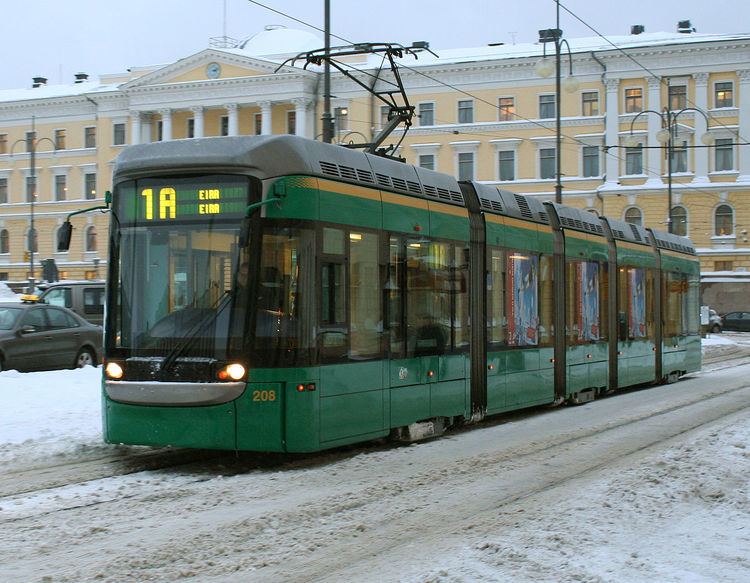Locale Helsinki, Finland Number of lines 13 Began operation 1891 | Transit type Tram Daily ridership 200,000 (weekdays) Operator(s) HKL | |
 | ||
The Helsinki tram network forms part of the Helsinki public transport system organised by Helsinki Regional Transport Authority and operated by Helsinki City Transport (Finnish: Helsingin kaupungin liikenne, Swedish: Helsingfors stads trafikverk) in the Finnish capital city of Helsinki. The trams are the main means of transport in the city centre. 56.7 million trips were made in 2013. The Helsinki system is one of the oldest electrified tram networks in the world.
Contents
Lines
In 2016, approximately 38 km (23.6 mi) of double track was in operation with 13 routes.
Additional lines
In addition to the 13 regular lines two special ones exist: the museum line operated by Helsinki City Transport in collaboration with Oy Stadin Ratikat Ab and the Spårakoff pub tram, both of which run during the summer months. These lines do not appear in the route map included with this article.
Technology and infrastructure
The tram network is built almost exclusively on the streets of Helsinki, making it a traditional tram system rather than a light rail one. The track gauge is one metre. The network consists almost entirely of double track. In some parts the tracks are separated from other road traffic; elsewhere they share road space with cars and buses.
The trams are powered with electricity conveyed by overhead wires. Trams have their own traffic lights, distinguished from normal lights in that they are based on symbols of single colour: an upward-pointing arrow signifies "go", a horizontal line "prepare to stop" and the letter S "stop". The traffic lights are synchronised to allow tram and bus traffic to flow relatively smoothly. This system is called HeLMi (Helsinki Public Transport Signal Priority and Passenger Information).
Depots
As of 2010, there are four tram depots/workshops in Helsinki; HKL-maintained depots in Töölö, Vallila and Koskela, and a Bombardier Transportation-maintained workshop at Pasilan konepaja.
Planning process is under way (as of October 2008) for excavating a new underground tram depot in the base rock below the existing Vallila depot and adjacent city blocks. The underground depot is planned to have facilities for housing 180 trams plus repair facilities and staff parking spaces. The underground depot would partially or completely replace the Koskela depot, which is inconveniently located far from normally operated tram lines and would require major reconstruction if kept in use. An alternative is rebuilding and expanding the Koskela depot, but this is projected to be more expensive than the planned underground depot.
Rolling stock
As of February 2015, HKL has up to 124 tram units that can be used in scheduled passenger service. HKL reported that it used 97 trams to operate peak-time scheduled traffic in the spring of 2013. Additionally, there are six trams in reserve and eight in charter use. The MLNRV I and II series (rebuilt Valmet Nr I and Valmet Nr II units), MLNRV Variotram, and Valmet NrI series comprise the current backbone of the fleet, but HKL is in the process of receiving 40 new Transtech Artic units.
In 2006–12, all Valmet Nr II+ vehicles underwent a major modification process in which a 6.5 m (21 ft 4 in) low-floor midsection was added to the tram. The type designation was changed from Nr II+ to MLNRV to reflect the modifications made, and the longer trams were re-introduced in traffic gradually as the modification works were completed. During the process, HKL decided to also rebuild ten of the older Nr I trams in the same way, which brought the total number of MLNRV trams to 52 upon completion in mid-2014.
The fully low-floor Variotram units, acquired in 1998–2003 from Adtranz (later Bombardier) and built by Transtech Oy in Otanmäki, proved to be unreliable, causing a shortage of operable trams. Starting in 2004, HKL purchased ten DUEWAG series second-hand trams from Mannheim in Germany to cover for the shortage. Eventually arrangements were made with Bombardier to keep a sufficient number of the units in operation. All of the DUEWAG units were either withdrawn or relegated to charter service by the end of 2014.
HKL is now in the process of acquiring 40 new low-floor Artic trams from Transtech. They have a double-articulated, eight-axle design, are 27.3 m (89 ft 7 in) long and have 74 fixed seats, 14 foldable seats and space for 75 standing passengers. The design has a 100% low floor and conventional, turning bogies designed to run without problems on Helsinki's challenging old-fashioned track network. Two prototype units were delivered in 2013, and each entered passenger service approximately two months after delivery. The first unit of the production series, no. 403, arrived in Helsinki in January 2016. The order is worth €113 million and it includes an option for a further 90 trams.
To ease the construction of new tram tracks into Jätkäsaari beginning in 2009, HKL considered using bi-directional trams on the new line. However, HKL decided to build the Jätkäsaari extensions with conventional return loops and to use the existing uni-directional rolling stock. The next time bi-directional rolling stock might be considered is the conversion of the orbital trunk bus line 550 (formerly branded Jokeri) into light rail.
The following table lists the current rolling stock. Corresponding articles have further details about the cars in use.
